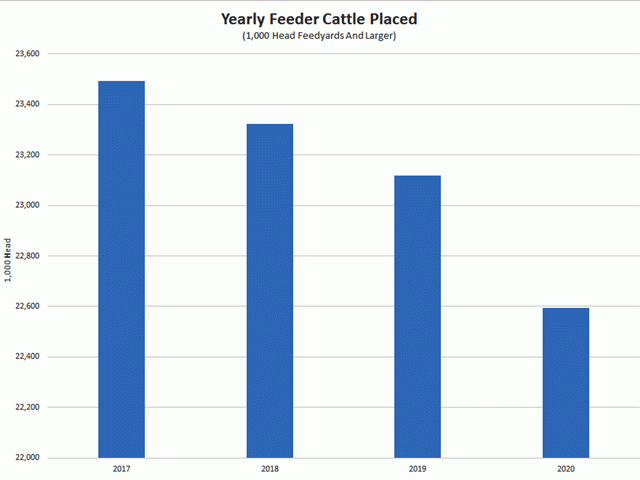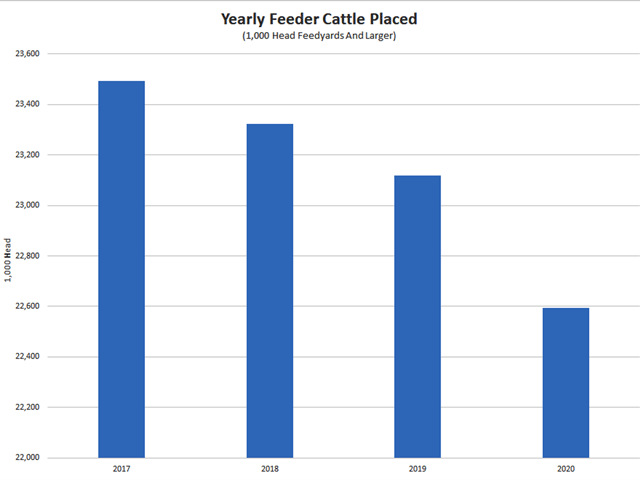Sort & Cull
Where Are Half-Million Calves Hiding?
The Dec. 1 Cattle on Feed report, released Friday, Dec. 18, came and went without much drama or market excitement, with report totals falling in-line nicely with pre-report estimates. Total cattle on feed numbers were essentially unchanged from year ago levels with a total of 12 million head of cattle in the nations feedlot system (feedlots with 1,000 head and above). Total cattle marketed through the month of November hit 1.78 million head, 98% of year ago levels and once again spot-on with pre-report estimates.
Cattle placements posted the largest shift from year ago levels with 1.9 million head placed in commercial feedlots, coming in at 91% year ago levels. This was also within 0.5% of analyst estimates and close enough to not create any significant market actions early in the week. These numbers pointed to stability in feedyard numbers and strong marketing actions taking place heading into the end of the year. It also pointed to reduced cattle placement numbers, which does very little for short-term market moves, but points to tighter supplies of cattle during the second half of 2021. This is viewed as long-term bullish for the live cattle complex as less cattle from feedlots being available to packers in the late second quarter through the third quarter of 2021 should help to solidify price support and potential profitability.
The challenge comes when we start digging below surface of these numbers, creating some questions that seem to not even be asked at this point, given the turmoil seen over the last year and the hope for more positive news in the coming year.
A quick glance at seasonal placement charts points out that the feeder cattle marketing surge during the months of October and November didn't develop, with cattle placements in October and November ranked as the fourth lowest of the last five years. Even though placements in July through September beat previous years placement levels, the overall result of this still leaves the market extremely short compared to previous years feedlot placements.
On average, 2020 cattle placements, in 1,000-head lots and larger (I will touch on the importance of this distinction later) fell 719,000 head below the previous three years.
P[L1] D[0x0] M[300x250] OOP[F] ADUNIT[] T[]
Where did all of these additional calves go?
It is true that there are less calves available to move into the system, with the annual calf crop reduced 250,000 head last year. This follows the general retraction of the overall beef herd seen over the past couple of years. But even with these lower calf numbers, there remain nearly 500,000 head of calves unaccounted for when trying to balance yearly feeder cattle placement numbers.
When finding solutions for the "missing" calves, there seems to be three logical explanations as to why overall feeder cattle placements in 2020 slipped 3% to 4% from previous year levels.
The first potential explanation could be that the reduction of calves moving into feedlot systems is based on a significant increase in heifers being retained in the beef-cow herd. Even though there have been reports of some heifers being held back, that doesn't seem likely to be where most of these calves have moved considering the current status of the market and the fact that the nation's beef herd is expected to slowly contract over the next year.
The addition of drought in several large cattle producing regions of the country, as well as elevated feed prices, and in some areas discounted cow prices, is likely not the main outlet for these extra cattle during the 2020 year, but if significant increases are seen in beef herd replacements, this creates caution over the next two to three years, meaning larger calf crops in the coming future; putting further supply pressure on the entire industry.
The second viable option to explain these recent placement levels is that these calves may be placed in feedyards under the 1,000 head threshold and, therefore, not counted by the Cattle on Feed reports. Price volatility and uncertainty in the market through the last year likely caused more cattle to move into smaller, farmer/feeder-owned feedlots over the last several months. This will likely limit these cattle from moving into larger feedlots through their lifetime and they will never be accounted for in the reports. The potential for market moves is lies in the fact that total supplies will not be as tight as currently expected due to market-ready cattle moving into the packer system during the June through September timeline from these smaller feedyards.
The third potential explanation is the expectation that a portion of these "unfound" calves have been unsold and held over on grass or wheat through the early winter months. Cow-calf producers could be looking for better pricing opportunities after the first of the year before either selling feeder cattle or retaining ownership into feedlots. This has the potential to increase cattle placements in the January, February and March reports. These placements would increase the number of heavier weight cattle in the upcoming Cattle on Feed reports, limiting the optimism of substantially tight supplies of market-ready cattle during 2021.
It is likely a combination of all the above scenarios collectively accounted for the lower feeder cattle placement levels seen during 2020. Total yearly placements are still running 3% to 4% below recent year levels and, while those calves and yearlings are likely still out there, they are not currently in the traditional feedlot systems. The volatility of the markets and the price pressure in cattle markets are causing cattle producers to react in nontraditional ways, which affects seasonal marketing patterns, but hopefully allows for some opportunities in the coming months.
However, sooner or later, it is expected that most of the "hidden" calves will be found.
Rick Kment can be reached at rick.kment@dtn.com
(c) Copyright 2020 DTN, LLC. All rights reserved.






Comments
To comment, please Log In or Join our Community .